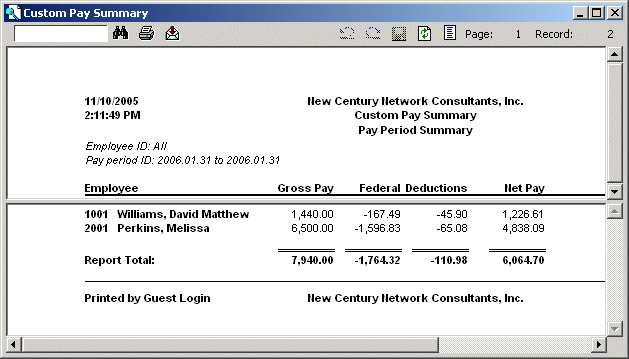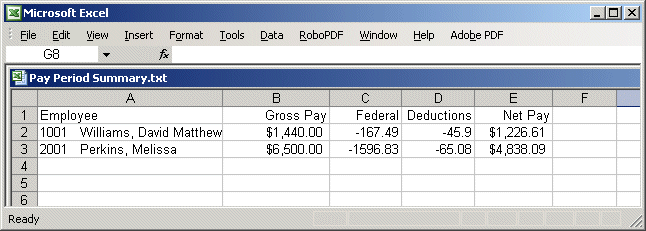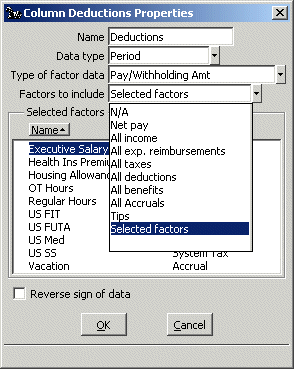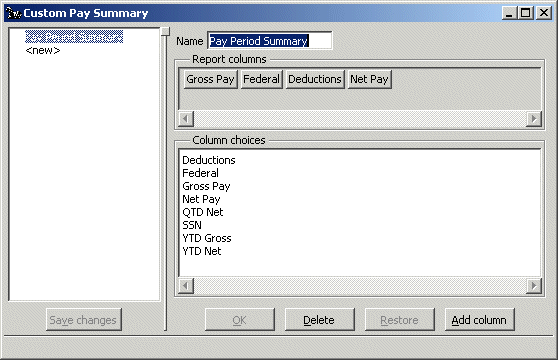21st Century Payroll for Adagio Tutorials - Payroll
How do I print a one-line-per-employee or one-line-per-pay-period summary report?
Payroll/Configure/Custom Pay Summary and /Print/Custom Pay SummaryThe Custom Pay Summary report in Payroll lets you create and print any number of summary per-employee or per-pay period reports that fit the needs of your company. The many different possibilities and the speed of the report allow you to experiment until you get what you want!
For example, you can print or export a one-line-per-employee summary of pay period activity that looks like this (in slightly different tutorial data) in 21st Century Payroll:
Or like this when you export it to Excel:

To create the report shown above, follow these steps.
- Run System/Company/Select and double-click TutCo in in the Select Company window. TutCo is the company you created in the "Create a new company" lesson.
- Run Payroll/Configure/Custom Pay Summary.
- In the Custom Pay Summary window, with <new> highlighted, press the Tab key.
- Type a "Name" for the report. For example, type Pay Period Summary and press Tab.
- Using your mouse, grab "Gross Pay" from the Column choices box. Drag it to the Report columns box and drop it in the upper left corner.
- Grab "Federal" from the Column choices box, move it to the right of "Gross Pay" in the Report columns box and drop it.
- Grab "Net Pay" from the Column choices box, move it to the right of "Federal" in the Report columns box and drop it.
- Click the Add column button at the bottom right of the Custom Pay Summary window.
- In the Column Properties window that pops open, type Deductions for the "Name."
- The default "Data type" (Period) and "Type of factor data" (Pay/Withholding Amt) are the types of datas you want. Click the drop-down arrow beside each field to see what the other choices are.
- Click the drop-down arrow beside the "Factors to include" field to see how you can summarize or itemize pay factors.

- Click All deductions in the "Factors to include" list to enter it in the field, press the Tab key, and click the OK button at the bottom of the Column Properties window.
- Grab "Deductions" from the Column choices box, move it to the right of "Federal" in the Report columns box and drop it. Notice that a red line appears between "Federal" and "Net Pay" to show where your new column will appear.
- Click the OK button below the Column choices box.
Your finished report definition should look like this:

- Click the Save changes button at lower left to save the report.
The Custom Pay Summary provides a number of predefined columns such as (for example) Gross Pay (all incomes summed into a single amount), Net Pay (net pay), and Federal taxes (US FIT, US SS tax, and US Medicare tax summed into a single amount). You can modify the predefined columns and create your own columns.
To drag and drop, put your mouse pointer on the item, click and hold down the mouse clicker button, move the item to where you want it, and release the clicker button.
Some employees have other deductions from income besides federal taxes. To print a summary of all deductions on your report, for example, you create a new column.
Notice that you can select individual factors or get the system to summarize related factors such as all taxes, all deductions, all benefits, and so forth. If you wanted to select factors from the Selected factors box, you would press the spacebar or double-click with the mouse to check the ones you want.
To print the report shown above, follow these steps.
- Run Payroll/Print/Custom Pay Summary.
- At Report name, select the report you created, Pay Period Summary.
- Select All employee IDs.
- At Pay period ID, select from 2001.06.30 to 2001.06.30 (or any pay period for which the company you're using has data).
- Use the Sort options, by Employee, then by Pay Period, and click Summarize to turn it on.
- Click Preview or Print to print the report (or click Export to export a text file that you can view in Excel or any spreadsheet).
Back To Top | Back To Main Tutorials Page
